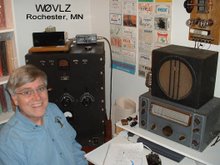After building/using my two C-Pole array I'm starting to rethink my plan.
KF2YN's C-Pole vertical array design calls for dedicated C-Poles (each pruned to have a 25 ohm input impedance) and phasing lines that both transform the antenna impedance to 100 ohms and set the phase delay between the two antennas. On the surface this looks doable but I've a lot of concern about getting the phasing lines right. W8WWV's measurements showed about a 4% delta as he measured the electrical length of a 17.1' long piece of coax. Also, I don't want to dedicate two C-Poles to an antenna that I won't be using much.
A local friend of mine wants to build a self supporting C-Pole antenna like mine. I can feed two verticals with arbitrary (but equal) lengths of coax and a simple Tee connector at the antenna tuner to make up for the 25 ohm combined feed impedance...no need to worry about electrical lengths. In addition, self supporting antennas can be positioned anywhere to point my signal where I want it to go that day. I can even boost the gain a little (up to 4.8 dB) by separating the antennas 5/8 wavelength.
It's still August, I should have another couple of months of outside weather here in Minnesota.
Monday, August 23, 2010
Wednesday, August 11, 2010
A Two C-Pole Steerable Array

Yesterday I finally got my two C-Pole phased array up and on the air. In fact, after tuning it a little I easily made two QRP contacts, one with N2UGB in NY and the other with CT4RL/1 in Portugal.
My journey from idea to an antenna was based on Chapter 13.3, "A Steerable C-Pole Array" in Brian Cake's book, "Antenna Designer's Notebook". Here Brian presented a design based on phased array theory and modeling. Brian was not aware of anyone that had actually built one.
The C-Poles themselves are made from Radio Shack 18 gauge stranded hookup wire. 1/2" PVC pipe is used for the top and bottom 40" spreaders. For easy supporting, the two C-Poles are in the same plane and aligned with the rope joining the two antennas. The upper inside corners of the antennas are connected by a 33.5' length of rope. This insures correct spacing. Support ropes are tied to the two top outside corners. Instead of a relay I used a coax T connector. L3 was added/removed as needed to change the radiation pattern.
Without L3 the array is endfire and, according to Brian's modeling, good for 1.18dBi gain. By adding L3 into the short/L2 side both sides become 3/4 wavelength long and the array has 3.5 dBi gain broadside.
I learned a little along the way about...
- Baluns and phasing lines...The phasing lengths include the phase delay introduced by the required choke baluns. I had planned to use air core baluns consisting of RG-8X wound around 4" plastic coffee "cans". What I found was that each balun takes about 1/4 wavelength (electrically) of coax. By the time I added the baluns to L1 and L2 in the accompanying diagram I couldn't separate the antenna by a physical half wave. I was forced to use more expensive ferrite toroid baluns that require less coax.
- Adding/removing L3...The switch/relay proposed by Brian in his design introduced its own challenges. The relay/switch is part of the phasing network. I found that my DPDT toggle switch with the needed connectors introduced more phase delay to the point that I was again in trouble with the physical separation of the two antennas. I eventually used a T connector instead.
- Supports...Finding trees with the right separation, orientation, height and limb placement can be a problem...especially for a temporary installation in the park.
- Measuring the electrical length of coax...My MFJ Antenna Analyzer gave a broad X=0 reading. My grip dip meter gave a sharp dip but not on the same frequency as the MFJ (The ARRL Antenna Book recommends against using a dip meter). Eventually I averaged the two MFJ endpoint/X=0 readings to get a center/single frequency and then calculated the coax electrical length based on that frequency.
- Gain...1 to 3.5 dBi of gain is hard to notice when asking for signal strength comparisons under real band conditions.
Subscribe to:
Posts (Atom)
